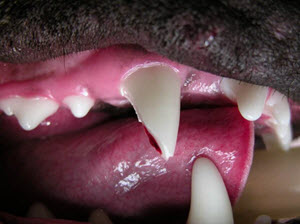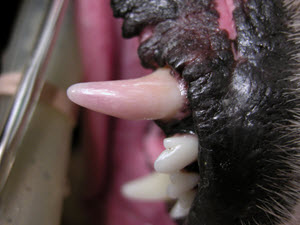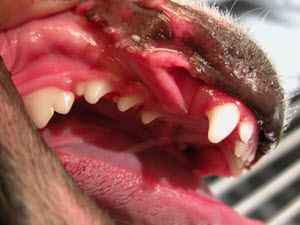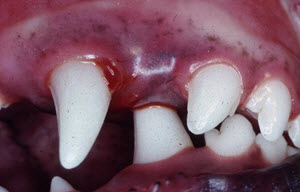Our dental services include teeth cleaning and polishing, digital dental radiography (x-rays), tooth extractions and minor oral surgery. Our Doctors strongly recommend at-home dental care which consists of you brushing your pet’s teeth. Maintaining the health of your pet’s teeth and gums will help with your pet’s overall health and longevity. Besides developing pain and odor, there can be important ramifications if your pet develops dental disease. Studies have shown links between diseases of the heart, kidney and liver in pets with dental disease. Your pet’s teeth, just like your teeth, when not brushed will begin to accumulate bacteria. If left, the bacteria can cause plaque and tarter to buildup on the teeth. The result can cause bad breath, reddeded gums, and progress to further periodontal disease. As dental disease progresses, other signs can include drooling, discomfort while chewing, and loose or missing teeth. But how do you know if your pet has a healthy mouth? Let us examine your pet’s teeth and gums to help determine if there are any dental issues you should know about. Signs that your pet may have an oral health problem include:
- Bad breath
- Bleeding and inflamed gums
- Build up of yellow or brown tartar on the teeth
- Pain or discomfort when chewing food
- Pawing at the mouth
- Drooling excessively
- Blood-tinged saliva
- Change of eating habits or loss of interest in food
- Tooth Loss
What causes dental disease?
When your pet eats, trapped food particles stuck between the teeth are digested by bacteria to form plaque, a yellow, sticky coating on the teeth. As the plaque continues to build, then gums become inflamed and infected and this is a condition known as gingivitis. This is seen as redness, and occasionally bleeding along the gum line above the teeth. With time, the plaque eventually hardens to form tartar, which holds the bacteria to the surface of the teeth and pushes it under the gum line. This deeper infection of the tooth’s supporting structures (i.e. bone) is known as periodontal disease. It can progress to loss of the infected teeth, bone around the teeth being dissolved, and bacteria being shed into the bloodstream to spread throughout the body.
Does at home dental care make a difference?
Yes, preventative dental care can make a significant difference in your pet’s dental health. Preventative care can range from brushing your pets teeth daily, to oral rinses, to chews and toys designed to help clean your pets teeth, even to diets specifically designed to help remove and prevent plaque. Click Play below to watch Dr. Hill demonstrate how to brush your dog’s teeth:
What type of brush do I need?
Ideally you should use a veterinary toothbrush or “finger” brush. If you cannot purchase a veterinary toothbrush, you can tray a child’s soft bristled brush.
What is the best toothpaste to use?
Pet toothpastes come in a variety of flavors including chicken, beef, and malt. Experiment and find the one that suits your needs best. Do NOT use your toothpaste on your pet. Human toothpastes have detergents and sudsing agents that are not meant to be swallowed and may be harmful to your pet.
Brushing Tips:
- The most important teeth to brush are the back, upper premolars (the biggest teeth you can see in the back of the mouth). Also important are the canine teeth and incisors.
- Brushing the inside of the teeth is not necessary.
- A “finger” brush (one that fits over your finger and has short bristles) may make brushing easier, especially in cats.
- Brushing daily is ideal. If this is not possible, at least 2-3 times a week is recommended.
Will feeding your pet dry food prevent dental problems? Diet is probably much less important to prevent tartar buildup than most people think. Dry food is less sticky, of course, and does not adhere to the teeth as readily as canned food. But, eating dry food does not remove tartar from the teeth. Certain chewing toys or strips (especially those that contain enzymes) designed to clean the teeth may help tartar buildup somewhat, but once plaque on the teeth has hardened and formed tartar, simple brushing and chews cannot remove it, and your pet has progressed to the point of needing a dental scaling and polishing under general anesthesia by your veterinarian. How can you tell if your pet has dental disease? If your pet will let you safely touch and look in its mouth, lift your pet’s lip and look at the teeth in the back of the mouth as well as those in the front. If you see brown or yellow crusty material attached to the teeth, smell a foul odor, or see redness along the line where the tooth and gums meet, or see loose or cracked teeth, you should call and schedule a dental consultation with your veterinarian.
Common Pet Dental Problems
There are a variety of pet dental conditions that may affect your dog or cat, some of which are very painful for them. Below are many common pet dental conditions, if you notice any of these conditions in your pet’s mouth, you should contact us for an evaluation, and treatment plan.
Abscessed Pet Teeth
An abscessed tooth is an advanced form of an infected tooth, and is most commonly seen on the upper jaw just below the dog or cat’s eye. This condition is usually caused by a fractured tooth that has been infected by the oral bacteria and the tooth eventually dies. The bacteria will travel through the bottom of the roots. Once the infection reaches the jaw, it also has access to the entire body through the blood vessels. Read more: Abscessed Pet Teeth
Broken Pet Teeth
Broken (fractured) teeth are a very common occurrence in dogs and cats. Pet teeth can break due to trauma (hit by care, ball or rock) or due to chewing on hard objects. Any pet tooth can break, however some teeth are more commonly fractured than others, such as the canine (fang) teeth in the dog and the cat, and the upper fourth premolar (large tooth on the upper jaw in the back of the mouth) in dogs. Read more: Broken Pet Teeth
Discolored Pet Teeth
Any pet tooth that is not the normal color is almost certainly dead and infected. This means that teeth which are purple, yellow, grey, or brown are very likely to be a significant problem for your pet. In fact, it is estimated that 93% of discolored teeth are dead and infected, which means that can be painful and/or infected to your dog or cat. Unfortunately dogs and cats almost never show obvious signs of oral pain, therefore they often go untreated. Read more: Discolored Pet Teeth
“Missing” Pet Teeth
If you notice your pet is missing a tooth, it can be a serious problem. It is exceedingly common for teeth to be absent in our pets. In some cases, the tooth is truly missing, while in others the tooth/root is actually present under the gumline. These teeth are usually a problem. Do not assume a tooth is truly absent or that it was previously extracted just because it is not seen above the gumline. Dental x-rays must be taken of the area to confirm true absence of the tooth. Read more: “Missing” Pet Teeth
Pet Cavities
True bacterial cavities (called caries) are fairly rare in animal patients, but they do occur in dogs. The breed that is most often affected is the German Shepherd dog, although any breed can develop cavities. The most common are of the mouth for cavities to occur is on the flat, top surface of the molar teeth, but they can occur anywhere. Read more: Pet Cavities
Pet Orthodontic (Bite) Problems
Orthodontic problems are not unusual in dogs, but are fairly uncommon in cats. A malocclusion means that the jaws do not align properly. This problem may be purely cosmetic or can cause trauma to the lips, gums, palate or teeth. Read more: Pet Orthodontic (Bite) Problems
Pet Tooth Resorption
While pet tooth resorption is typically thought of as a feline condition, we are seeing more and more of this in our canine patients as well. This problem is very common in cats, with studies suggesting that up to 60# of cats over 6 years of age are affected. Feline tooth resorption is second only to periodontal disease in the overall incidence of oral disease. Read more: Pet Tooth Resorption
Retained Deciduous (Puppy) Teeth
A deciduous pet tooth is considered retained as soon as the permanent (adult) tooth erupts. The permanent pet tooth does not need to be fully erupted for the deciduous to be considered retained. Read more: Retained Deciduous (Puppy) Teeth
Worn Pet Teeth
Excessive wear of pet teeth can actually cause problems, and there are many reasons this can occur in dogs and cats. Some of the most common causes of worn pet teeth are chewing on tennis balls and other toys as well as itching/chewing as a result of skin allergies. Read more: Worn Pet Teeth













